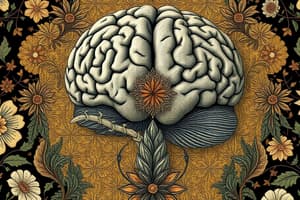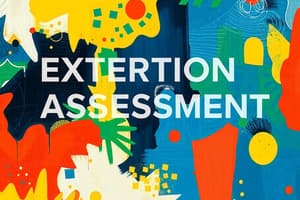Podcast
Questions and Answers
What is the primary aim of conducting an external audit?
What is the primary aim of conducting an external audit?
- To develop a comprehensive list of opportunities and threats. (correct)
- To ensure compliance with accounting standards.
- To analyze the company's financial performance.
- To identify internal operational inefficiencies.
In strategic management, what does an external assessment primarily involve?
In strategic management, what does an external assessment primarily involve?
- Analyzing internal strengths and weaknesses.
- Setting long-term organizational goals.
- Reviewing past financial statements.
- Identifying and analyzing factors outside the organization that could impact its performance. (correct)
How do managers prioritize key factors identified during an external audit?
How do managers prioritize key factors identified during an external audit?
- By individually ranking opportunities and threats from most to least important, then building consensus. (correct)
- By immediately developing strategies for all identified factors.
- By focusing solely on factors that can be easily addressed.
- By only considering factors that align with the company's mission statement.
Which of the following is NOT typically considered in a PESTEL analysis?
Which of the following is NOT typically considered in a PESTEL analysis?
Which of Porter's Five Forces considers the impact of similar products or services on an industry?
Which of Porter's Five Forces considers the impact of similar products or services on an industry?
According to the Industrial Organization (I/O) view, what primarily determines organizational performance?
According to the Industrial Organization (I/O) view, what primarily determines organizational performance?
Which of the following is an example of a social force that could impact an organization?
Which of the following is an example of a social force that could impact an organization?
How can political instability affect businesses?
How can political instability affect businesses?
Why is it important for businesses to stay informed about political developments?
Why is it important for businesses to stay informed about political developments?
Which of the following illustrates the impact of technological forces on strategic management?
Which of the following illustrates the impact of technological forces on strategic management?
What is the primary focus of competitive intelligence?
What is the primary focus of competitive intelligence?
According to Porter's Five Forces, what does the 'threat of new entrants' refer to?
According to Porter's Five Forces, what does the 'threat of new entrants' refer to?
What does 'market commonality' refer to in the context of competitive forces?
What does 'market commonality' refer to in the context of competitive forces?
What is the External Factor Evaluation (EFE) matrix used for?
What is the External Factor Evaluation (EFE) matrix used for?
In the context of external assessment, what is the primary goal of understanding external factors?
In the context of external assessment, what is the primary goal of understanding external factors?
What does the process of an external audit in strategic management involve?
What does the process of an external audit in strategic management involve?
Which step is crucial in the external auditing process?
Which step is crucial in the external auditing process?
What is the purpose of 'Present Findings' in the context of communicating an external audit?
What is the purpose of 'Present Findings' in the context of communicating an external audit?
What is the main purpose of the Competitive Pricing Matrix (CPM)?
What is the main purpose of the Competitive Pricing Matrix (CPM)?
How can a high unemployment rate potentially impact a company's sales and revenue?
How can a high unemployment rate potentially impact a company's sales and revenue?
What can fluctuations in exchange rates affect for international businesses?
What can fluctuations in exchange rates affect for international businesses?
How can climate change impacts affect an organization?
How can climate change impacts affect an organization?
Which of the following is an example of a governmental force that could impact a business?
Which of the following is an example of a governmental force that could impact a business?
How do legal frameworks for contracts affect business transactions?
How do legal frameworks for contracts affect business transactions?
What impact can technology like automation have on business production processes?
What impact can technology like automation have on business production processes?
In what area have digital marketing and e-commerce transformed how companies operate?
In what area have digital marketing and e-commerce transformed how companies operate?
Why is cybersecurity increasingly important for businesses today?
Why is cybersecurity increasingly important for businesses today?
What are the key elements companies must do to stay competitive when it comes to their technology strategy?
What are the key elements companies must do to stay competitive when it comes to their technology strategy?
Which of the following describes how competitor's weaknesses may affect a company?
Which of the following describes how competitor's weaknesses may affect a company?
What is one of the key missions of a Competitive Intelligence (CI) Program?
What is one of the key missions of a Competitive Intelligence (CI) Program?
What factors does the analysis of competitive forces typically include?
What factors does the analysis of competitive forces typically include?
According to Porter's Five Forces, what is 'rivalry among competing firms'?
According to Porter's Five Forces, what is 'rivalry among competing firms'?
What are some of the main 'Barriers to entry' that can affect competiveness?
What are some of the main 'Barriers to entry' that can affect competiveness?
How do substitute products affect competition among existing firms?
How do substitute products affect competition among existing firms?
What occurs when customer bases are larger and more centralized?
What occurs when customer bases are larger and more centralized?
What has the internet enabled firms to achieve when it comes to external source material?
What has the internet enabled firms to achieve when it comes to external source material?
What are assumptions based on when it comes to their impact on performance?
What are assumptions based on when it comes to their impact on performance?
The Competitive Profile Matrix (CPM) is most effective when analyzing which factors?
The Competitive Profile Matrix (CPM) is most effective when analyzing which factors?
Is the following statement true or false: Cooperative agreements between competitors are even becoming popular. For collaboration between competitors to succeed, both firms must contribute something distinctive, such as technology, distribution, basic research, or manufacturing capacity, along with tighter formal agreements.
Is the following statement true or false: Cooperative agreements between competitors are even becoming popular. For collaboration between competitors to succeed, both firms must contribute something distinctive, such as technology, distribution, basic research, or manufacturing capacity, along with tighter formal agreements.
Flashcards
What is an external audit?
What is an external audit?
A review by an independent auditor to verify financial statements and confirm compliance.
What is an external assessment?
What is an external assessment?
A tool in strategic management to identify and analyze external factors that may create opportunities and/or threats.
What is environmental analysis?
What is environmental analysis?
The systematic study of a company's outside environment to spot chances for growth.
What are economic forces?
What are economic forces?
Signup and view all the flashcards
What is inflation?
What is inflation?
Signup and view all the flashcards
What are exchange rates?
What are exchange rates?
Signup and view all the flashcards
What is consumer spending?
What is consumer spending?
Signup and view all the flashcards
What are social & cultural forces?
What are social & cultural forces?
Signup and view all the flashcards
What are demographic forces?
What are demographic forces?
Signup and view all the flashcards
What are natural environment forces?
What are natural environment forces?
Signup and view all the flashcards
What are political forces?
What are political forces?
Signup and view all the flashcards
What are governmental forces?
What are governmental forces?
Signup and view all the flashcards
What are legal forces?
What are legal forces?
Signup and view all the flashcards
What is competitive intelligence (CI)?
What is competitive intelligence (CI)?
Signup and view all the flashcards
What are technological forces?
What are technological forces?
Signup and view all the flashcards
What is production and logistics?
What is production and logistics?
Signup and view all the flashcards
What are marketing and sales?
What are marketing and sales?
Signup and view all the flashcards
What is information & communication?
What is information & communication?
Signup and view all the flashcards
What is innovation?
What is innovation?
Signup and view all the flashcards
What is cybersecurity?
What is cybersecurity?
Signup and view all the flashcards
What is Industrial Organization?
What is Industrial Organization?
Signup and view all the flashcards
What is EFEM?
What is EFEM?
Signup and view all the flashcards
What is CPM?
What is CPM?
Signup and view all the flashcards
What is the External Factor Evaluation Matrix?
What is the External Factor Evaluation Matrix?
Signup and view all the flashcards
What are competitive forces?
What are competitive forces?
Signup and view all the flashcards
What is a corporation among competitors?
What is a corporation among competitors?
Signup and view all the flashcards
What is market commonality?
What is market commonality?
Signup and view all the flashcards
What are forecasting tools?
What are forecasting tools?
Signup and view all the flashcards
What are quantitative forecasts?
What are quantitative forecasts?
Signup and view all the flashcards
What is making assumptions?
What is making assumptions?
Signup and view all the flashcards
What are qualitative forecasts?
What are qualitative forecasts?
Signup and view all the flashcards
What is the threat of new entrants?
What is the threat of new entrants?
Signup and view all the flashcards
What is the intensity of rivalry?
What is the intensity of rivalry?
Signup and view all the flashcards
What is the potential development of substitute products?
What is the potential development of substitute products?
Signup and view all the flashcards
What is the Bargaining power of suppliers?
What is the Bargaining power of suppliers?
Signup and view all the flashcards
What is the Bargaining power of consumers?
What is the Bargaining power of consumers?
Signup and view all the flashcards
Study Notes
The External Assessment
- It develops a finite list of opportunities that benefit a firm and threats to avoid.
- Aims to identify key variables offering actionable responses.
- It is a systematic process of examining a business's external environment to identify opportunities and threats.
- The primary goal is understanding how external factors influence an organization's ability to achieve its strategic objectives.
- Also known as environmental analysis, it identifies and analyzes factors outside an organization that could impact performance.
- External factors include economic, social, technological, and competitive trends.
External Audit
- It verifies a company's financial statements with an independent auditor.
- It ensures compliance with accounting standards and regulatory requirements.
- Involves a systematic assessment of external factors impacting an organization's strategy.
- Economic, social, political, technological, and competitive forces are considered to identify opportunities and threats.
- Provides an opinion on the fairness of a company’s financial statements.
External Auditing Process
- Gathering Information:
- Involves analyzing competitors' strengths, weaknesses, strategies, and market share.
- Including Porter's Five Forces (rivalry, new entrants, substitutes, suppliers, and buyers).
- Gathering data on economic, social, cultural, demographic, environmental, political, legal, and technological trends.
- Identifying Opportunities and Threats:
- Includes recognizing potential growth and expansion areas based on external trends and market conditions.
- Determines challenges and risks that could negatively impact the organization.
- Prioritizing Key Factors:
- Requires managers to individually rank identified opportunities and threats from most to least important.
- Necessitates facilitating discussions and meetings to reach a consensus on critical factors.
- Communicating Findings: Includes sharing the prioritized list of opportunities and threats with stakeholders.
- Developing Strategies:
- Consists of using gathered information to formulate strategic plans.
- To address the identified opportunities and threats.
Tools and Techniques for External Assessment
- PESTEL Analysis: Examines political, economic, social, technological, environmental, and legal factors.
- Porter's Five Forces: Analyzes industry rivalry, potential new entrants, substitute products, supplier power, and buyer power.
- External Factor Evaluation Matrix (EFEM): Is a tool used to evaluate the external environment and identify opportunities and threats.
- Competitive Profile Matrix (CPM): Compares a company's strengths and weaknesses against competitors.
Key External Forces
- Divided into five broad categories:
- Economic
- Social
- Cultural
- Demographical
- Environmental
- Political
- Governmental
- Legal
- Technological
- Competitive forces
Economic Forces
- Encompasses macroeconomic factors like inflation, interest rates, and unemployment.
- Has a major impact a company’s operations, competitiveness, and profitability.
- Inflation: Rising prices can erode consumer purchasing power and impact demand for goods and services.
- Interest Rates: Changes influence borrowing costs and affect business investment decisions and consumer spending habits.
- Economic Growth/Recession: Growth creates opportunities, while recessions lead to reduced demand and lower profits.
- Exchange Rates: Fluctuations affect the cost of imports, competitiveness of exports, and impact international businesses.
- Government Policies: Fiscal and monetary policies, including tax rates, government spending, and regulations, impact businesses.
- Consumer Spending: Consumer confidence and disposable income levels directly influence demand for goods services.
- Global Economic Trends: Conditions such as trade wars, pandemics, and geopolitical instability create uncertainty impacting businesses.
Social, Cultural, Demographic, and Natural Environment Forces
- It significantly influences an organizations chances, impacting its strategic decisions and overall success.
- Involves values, beliefs, customs, and lifestyles shaping consumer behavior and preferences.
- Examples include: changing attitudes towards sustainability, rise of social media, evolving family structure and shifting consumer preferences.
- Relates to population characteristics such as age, gender, income, education, and occupation.
- These are trends shaping how people live, work, produce, and consume.
- Examples: aging population, urbanization trends, ethnic demographics, and shifts in income distribution.
- Involves ecological factors, like climate change, resource availability, and environmental regulations.
- Examples: climate change impacts, resource scarcity, , pollution levels, and environmental regulations.
Some Key Social, Cultural, Demographic, and Environmental Variables
- Childbearing rates
- Number of special-interest groups
- Number of marriages
- Number of births
- Number of deaths
- Sex roles
- Immigration and emigration rates
- Social Security programs
- Social programs
- Attitudes toward government
- Attitudes toward retirement
- Attitudes toward leisure time
- Attitudes toward product quality
- Attitudes toward customer service
- Pollution control
- Attitude toward foreign peoples
- Energy conservation
- Lifestyles
- Traffic congestion
- Attitudes toward authority
Political Forces
- Encompasses government policies, political stability, and the political climate that influences business operations.
- Government policies like tax, trade restrictions, and regulations impact a company's costs, operations, and profitability.
- A stable political environment fosters predictability, while instability leads to uncertainty and disruption.
- Foreign trade policies involve tariffs, quotas, and trade agreements affecting international operations and competitiveness.
- Emerging political issues and trends such as environmental or social movements, can influence consumer behavior and business decisions.
- Businesses need to adapt their strategies and remain informed of political developments.
Governmental Forces
- Focus on the role of government in shaping the business environment, including regulations, oversight, and enforcement.
- Regulations regarding environmental protection, labor laws, or industry standards impact operational costs and processes.
- Government agencies that oversee regulatory compliance and influence risk management.
- Businesses relying on government contracts or subsidies need to anticipate changes in government policies and funding.
- To remain compliant and navigate regulatory landscapes businesses need an understanding of governmental forces .
Legal Forces
- Encompasses laws and legal frameworks governing business activities, including contract, intellectual property, and consumer protection law.
- Contract law provides legal frameworks for contracts and agreements that are crucial for partnerships and transactions.
- Intellectual property laws protecting patents, trademarks, and copyrights are essential for innovation.
- Impacts to marketing, product development, and customer relations is a result of consumer protection laws.
- Laws concerning employment practices effect human resource management.
- Businesses must ensure legal compliance, and understand how legal frameworks shape their competitive landscape.
Some Political, Governmental, and Legal Variables
- Government regulations or deregulatiions
- Special tariffs
- Import and export regulations
- Government fiscal and monetary policy
- Number, severity, and location of government protests
- Environmental Protection laws
- Level of defense expenditures
- Legislation on equal employment
- Number of patent
- Changes in tax laws
- Political action committees
- Voter participation rates
- Changes in Patent laws
- Political conditions in foreign countries
- Size of government budgets
- World oil, currency, and labor markets
- Location and severity of terrorist activities
Technological Forces
- Encompasses innovation and advancements in technologies that significantly impact strategic management .
- This influences how businesses operate, compete, and adapt to changing market conditions.
- New Technologies: Advancements create new models forcing companies to adapt or risk obsolescence.
- Digital marketing, e-commerce, and social media transform how companies reach customers and conduct sales.
- Enable faster and are the reason for efficient communication , collaboration, and data sharing technologies, for example the internet.
- Innovation: Leads to disruptive changes, requiring companies to develop new strategies to stay competitive.
- Cybersecurity: Brings about the need to protect systems which impacts security strategies.
Examples of Technological Forces (1/3)
- Artificial Intelligence (AI): Automates tasks, analyze data, personalize experiences which impact product development, marketing, and customer service strategies.
- Internet of Things (IoT): Permits devices to collect and transmit data which enables real-time monitoring, predictive maintenance, and new business models.
- Cloud Computing: Offers flexibility, scalability, and cost savings, impacting IT infrastructure and data storage strategies.
- Big Data Analytics: Can help companies gain insights into customer behavior which informs strategic decisions.
- Augmented Reality (AR) and Virtual Reality (VR): Can great immersive experiences to enhance training and provide new ways to interact with products and services.
Examples of Technological Forces (2/3)
- Technology Strategy:
- Companies need to develop a strategy that aligns with their overall business goals.
- Leveraging to achieve competitive advantage.
- Adaptability and Agility: Rapid change requires companies to be adaptable and agile.
- Innovation Management:
- effectively manage their innovation processes,
- identify and evaluate new technologies
- develop strategies to commercialize them.
Examples of Technological Forces (3/3)
- Collaboration and Partnerships: To be able to access new technologies and expertise, companies may need to collaborate with technology.
- Resource Allocation: Support technology investments, research and development, and talent acquisition
- Ethical Considerations: As technology becomes pervasive, companies need to consider the ethical implications of their decisions.
Competitive Intelligence (CI)
- It involves ethically gathering/analyzing info about the competition to further a business's own goals.
- It is a systematic and ethical process.
- Knowledge allows firms to formulate and implement effective strategies.
- Competitor weaknesses can represent potential opportunities.
- Major competitor strengths major threats.
- Provides a general understanding of an industry and its competitors.
- Identifies areas in which competitors are vulnerable.
- Its purpose to assess the impact that strategic actions would have on competitors.
- It will identify potential moves that a competitor might make and that would endanger a firm position.
Competitive Forces
- Are analyzed through Porter's Five Forces, which help organizations assess their industry's attractiveness.
- The following forces includes the threat:
- New entrants
- Bargaining power of suppliers and buyers
- Substitute products
- Rivalry among existing competitors
Seven characteristics that describe most competitive companies:
- Understand and remember what business you are in
- Innovate and make necessary improvement
- Acquisition is essential to growth
- If it's broke or not, fix it
- There is substitute for quality
- The value/threat for failing to cost-competitive
Cooperation Among Competitors
- Agreements between competitors are even becoming more popular.
- Firms must contribute a distinctive to succeed technology distribution, basic research or manufacturing capacity.
- A major risk is that unintended transfers skills or technology may occur at organizational levels.
- Firms often give away rival when operating under cooperative agreements.
- Information not covered often gets treated tighter formal agreement are needed!
Market Commonality
- Refers to the degree to which two firms operate in markets.
- Describes the extent to which firms compete, offering similar services.
Resource Similarity
- Alike a firm is about their competitor.
Competitive Analysis
- Porter’s five forces is used to help with developing strategies in mini industries.
- Defines the intensity of competition among firms.
According to Porter, the nature of competitiveness in a given industry can be composed of 5 forces:
- Rivalry firms
- Potential entry
- Development of substitutes
- Bargaining power of suppliers
- Bargaining power of consumers
Rivalry Among Competing Firms
- Usually the most powerful of the 5 forces.
- The firm can provide advantages.
- Has a relation to lower price and enhances the quality with warranties.
- How much firms put on pressure to limit the profit.
Potential Entry of New Competitors
- The way new competitor enter industry.
- Can easily enter market so poses a threat.
Barriers to entry Can Include:
- The need to gain economies of scale quickly,
- The need to gain technology specialized know-how.
- The lack experience
- Strong brand
- Possession of patents
- Large capital
- High government regular policies
Potential Development of Substitute Products
- It offer similar benefits to product some from a different industry.
- Less competitions among current firms so potential higher profit.
Bargaining Power of Suppliers
- When a large number of suppliers means bargaining affects intensity
- Mutual benefits to assist each other with improve quality.
- Increase profitability by development of services like just in time deliveries
Bargaining power of consumers
- The way customer offer extra service to increase service offer in power market for loyal customers.
- If purchase is stand consumers Can contract deals of selling price.
- Consumers can inexpensively switch brands if they feel one.
Increasing Bargaining Power
- Important of the consumer.
- Sellers are struggling.
- If they are discretion to make purchase.
Sources Of External Information
- Information is available organizations.
- customer survey
- markets speeches, interview, documents
- Internet has made to gather firms easier
Forecasting tools and techniques
- Forecast are educated assumptions related to future trends.
- Forecasting is complex based factors.
- Selected forecasting tools and are examined as essential.
Managers Often
- Most organization must develop with their own projections.
- Forecast annually
- Origination forecast their customer loyalty in local area.
Forecasting tools
- Forecasting quantitative and qualitative
- Quantitative historical are when and are key variable can be estimated
- Qualitative forecasts the expert instincts of and will interpret business
- Planning impossible with a assumption best estimate to managers impact.
The External Factor Evaluation
- Matrix management tools the evaluate organization external with threats.
Competitive Profile Matrix (CPM)
- Help organization with strength weakness to excel their competitors.
- The contribution is contribute brand and quality and service success
Studying That Suits You
Use AI to generate personalized quizzes and flashcards to suit your learning preferences.




